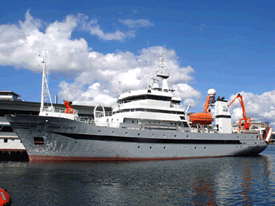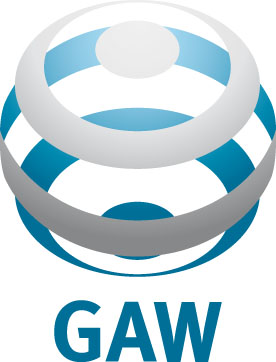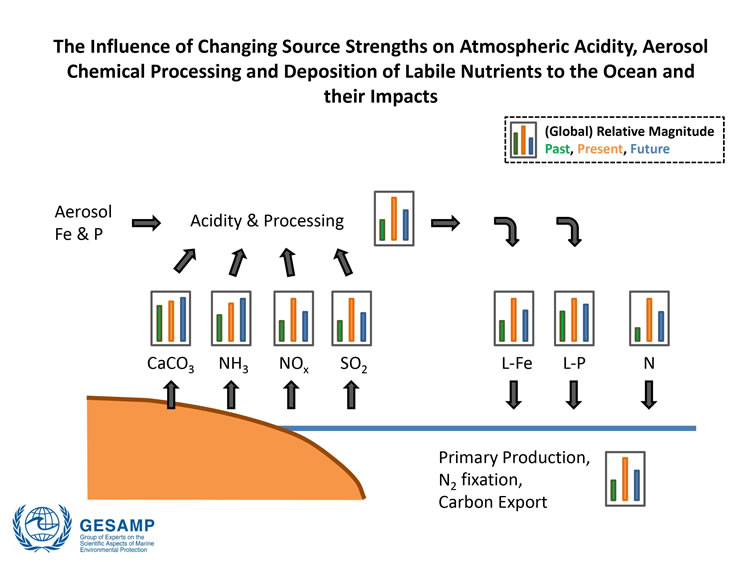GESAMP
 |
GESAMP |
 |
The Group of Experts on Scientific Aspects of Marine Environmental Protection (GESAMP) is an advisory body, established in 1969, that advises the United Nations (UN) system on the scientific aspects of marine environmental protection. At present it is jointly sponsored by eight UN organizations. GESAMP functions are to conduct and support marine environmental assessments, to undertake indepth studies, analyses, and reviews of specific topics, and to identify emerging issues regarding the state of the marine environment. WMO is one of the GESAMP sponsors.
History of WG 38
Working Group 38 was formed in 2008 because of growing concern about the impact of atmospheric deposition of both natural and anthropogenic substances on ocean chemistry, biology, and biogeochemistry as well as climate. It has held meetings at the University of Arizona, Tucson, AZ, in 2008, at IMO in London in 2010, in Malta in 2011, and at the University of East Anglia, Norwich, UK in 2013. Sponsors of those WG 38 efforts have included WMO, IMO, SCOR, SIDA, the European Commission Joint Research Centre, the University of Arizona, the International Environment Institute at the University of Malta, and the University of East Anglia, and the US National Science Foundation. Following the initial terms of reference, five scientific papers have been published in the peer-reviewed scientific literature, and these are listed at the end of this section.
Members
The Nitrogen Study and its Terms of Reference
Although the early work of Working Group 38 did consider some aspects of the deposition and impacts of atmospheric nitrogen species on the ocean, it was recognized that this was a significant and complex scientific issue that required a more in depth study. Thus, at GESAMP’s 39th session in 2012, Members approved additional terms of reference for continued work of GESAMP WG 38 to address issues related to the impact of the atmospheric deposition of anthropogenic nitrogen to the ocean. An abbreviated form of the new Terms of Reference were as follows:
• Update the geographical estimates of atmospheric anthropogenic nitrogen deposition to the global ocean;
• Re-evaluate the magnitude and impact of atmospheric nitrogen deposition on marine biogeochemistry;
• Provide a more reliable estimate of the impact of atmospheric anthropogenic nitrogen deposition on the production of additional nitrous oxide in the ocean and its subsequent emission to the atmosphere;
• Evaluate the extent to which anthropogenic nitrogen, delivered to the coastal zone via rivers, is transported to the open ocean; and
• Make a detailed estimate of the input and impact of anthropogenic nitrogen in the area of the Northern Indian Ocean and the South China Sea.
To address these new terms of reference, a highly successful and productive workshop on “The Atmospheric Deposition of Nitrogen and Its Impact on Marine Biogeochemistry” was held at the University of East Anglia in Norwich, United Kingdom, from 11 to 14 February 2013. Twenty-three scientists participated in the workshop. Sub-groups began the development of a number of scientific papers covering the task areas above. Six of these papers have been published in the peer-reviewed scientific literature and a seventh paper will be submitted in the latter part of 2017 (these are listed at the end of this section). This nitrogen workshop was supported by WMO, IMO, the University of East Anglia and the US National Science Foundation through SCOR.
Activities of WG 38 in 2017
From 27 February to March 2, 2017 two workshops took place at the University of East Anglia (UEA), Norwich, United Kingdom under the auspices of GESAMP Working Group 38 and sponsored by WMO, NSF, SCOR, SOLAS and UEA. These workshops focused on the changes in the acid/base balance of the atmosphere and ocean, and their impacts on air-sea exchange.
Workshop on the Impact of Ocean Acidification on Fluxes of Atmospheric non-CO2 Climate-Active Species

Earlier investigations on the impact of ocean acidification (OA) have primarily focused on changes in oceanic uptake of anthropogenic CO2, the resulting shifts in carbonate chemical equilibria and the consequences for marine calcifying organisms. Little attention has been paid to the direct impacts of OA on the ocean sources of a range of other gaseous and aerosol species (including N2O, CH4, DMS, and marine VOCs and halocarbons) that are influential in regulating radiative forcing, atmospheric oxidising capacity (via OH and O3 cycling) and atmospheric chemistry. The oceanic processes governing emissions of these species are frequently sensitive to the changes in pH and ocean pCO2 accompanying ocean acidification. The direct and indirect influences of these oceanic processes (e.g., microbial metabolic rates, levels of surface primary production, ecosystem composition, etc.) on ocean fluxes of non-CO2 trace gases and aerosols, and the subsequent feedbacks to climate remain highly uncertain. The goal of this workshop was to review and synthesize the current science on the direct impact of OA on marine emissions of these other key species; identify the primary needs for new research to improve understanding of these processes and quantify the impact of OA on marine fluxes; publish the results in the open peer-reviewed scientific literature, and provide input to national and international research programs and relevant WMO programmes.
Workshop on Changing Atmospheric Nutrient Solubility

Atmospheric deposition of nutrients to the ocean is known to play a significant role in regulating marine productivity and biogeochemistry, in turn potentially impacting the drawdown of CO2 from surface seawater as well as the production of other climate-active gases (e.g., N2O and DMS). The specific impact is dependent on the nutrient in question, the location of the deposition (more significant impact where a particular nutrient is in short supply), and the bioavailability of the deposited nutrient. Bioavailability is largely governed by the chemical speciation of a nutrient and, in general, insoluble species are not bioavailable. For Fe and P, solubility increases during transport through the atmosphere. The causes of this increase are complex, but interactions of aerosol particles with acids appear to play a significant role. Past and future changes in anthropogenic emissions of acidic (SO2 and NOx) and alkaline (NH3) gases have had and likely will have an impact on the acidity of the atmosphere downwind of major urban/industrial sources, with potential consequences to the supply of soluble nutrients to the ocean. Concurrent with this change in acidity there are likely to be other changes which may also impact marine productivity rates and microbial species population composition. The goal of this workshop was to review and synthesize the current scientific information on solubility of key biogeochemical elements, their pH sensitivity and the biogeochemical controls on the pH sensitivity; identify the key future research needs that are necessary to reduce uncertainties in predictive capability in this area; publish the results in the open peer-reviewed scientific literature; and interact with and provide information to leading relevant international groups (e.g., SOLAS, IGAC, IMBER, SCOR) and WMO programmes such as GAW.
To access the report of these two workshops please click on the link below
Report of the two workshops of GESAMP Working Group 38 (27 Feb-2 March 2017)
Meeting reports
- Report of the First Meeting of GESAMP Working Group 38, Tucson, AR, USA, 10-14 December 2008
- Report of the Second Meeting of GESAMP Working Group 38, London, UK, February 2010
- Report of the Third Meeting of GESAMP Working Group 38, Malta, March 2011
- Report of the Fouth Meeting of the GESAMP Working Group 38, Norwich, UK, 11-14 February 2013
GESAMP/GAW reports
- 203. The Atmospheric Input of Chemicals to the Ocean (GESAMP Report No 84)
- 202. Workshop on Modelling and Observing the Impacts of Dust Transport/Deposition on Marine Productivity, Sliema, Malta, 7-9 March 2011), (Prepared by Robert A. Duce and Prof. Peter Liss), 50 pp, November 2011
Scientific articles
- Okin, G., A. R. Baker, I. Tegen, N. M. Mahowald, F. J. Dentener, R A. Duce, J. N. Galloway, K. Hunter, M. Kanakidou, N. Kubilay, J. M. Prospero, M. Sarin, V. Surapipith, M. Uematsu, T. Zhu, “Impacts of atmospheric nutrient deposition on marine productivity: roles of nitrogen, phosphorus, and iron”, Global Biogeochemical Cycles, 25, GB2022, doi:10.1029/2010GB003858, (2011) http://www.agu.org/pubs/crossref/2011/2010GB003858.shtml
- Hunter, K.A., P. S. Liss, V. Surapipith, F. Dentener, R. A. Duce, M. Kanakidou, N. Kubilay, N. Mahowald, G. Okin, M. Sarin, I. Tegen, M. Uematsu, and T. Zhu, “Impacts of anthropogenic SOx, NOx and NH3 on acidification of coastal waters and shipping lanes”, Geophysical Research Letters, 38, L13602, doi:10.1029/2011GL047720 (2011) http://www.agu.org/pubs/crossref/2011/2011GL047720.shtml
- Kanakidou, M., R. Duce, J. Prospero, A. Baker, C. Benitez-Nelson F. J. Dentener, K.A. Hunter, N. Kubilay, P. S. Liss , N. Mahowald, G. Okin, M. Sarin, K. Tsigaridis, M. Uematsu, L.M. Zamora, and T. Zhu, “Atmospheric fluxes of organic N and P to the ocean”, Global Biogeochemical Cycles, 26, GB3026,doi:10.1029/2011GB004277, (2012)
- Schulz, M., J. M. Prospero, A. R. Baker, F. Dentener, L. Ickes, P. S. Liss, N. M. Mahowald, S. Nickovic, C. Pérez García-Pando, S. Rodríguez, M. Sarin, I. Tegen, R.A. Duce, “The atmospheric transport and deposition of mineral dust to the ocean - Implications for research needs”, Environmental Science and Technology, 46, 10,390-10,404 (2012)
- Hagens, M., K.A. Hunter, P.S. Liss, and J.L. Middelburg, “Biogeochemical context impacts seawater pH changes resulting from atmospheric sulfur and nitrogen deposition”, Geophysical Research Letters, 41, doi:10.1002/2013GL058796 (2014)
- Kim, T.-W., K. Lee, R. Duce, and P. Liss, “Impact of atmospheric nitrogen deposition on phytoplankton productivity in the South China Sea”, Geophysical Research Letters, 41, 3156–3162, doi:10.1002/2014GL059665. (2014).
- Somes, C.J., A. Landolphi, W. Koeve, and A. Oschlies, “Limited impact of atmospheric nitrogen deposition on marine productivity due to biogeochemical feedbacks in a global ocean model”, Geophysical Research Letters, 43, 4500–4509, doi: 10.1002/2016GL068335. (2016).
- Kanakidou, M., S. Myriokefalitakis, N. Daskalakas, G. Fanourgakis, A. Nenes, A.R. Baker, K. Tsigaridis, and N. Mihalopoulos, “Past, Present, and Future Atmospheric Nitrogen Deposition”, Journal of the Atmospheric Sciences, 73, 2039-2047, doi:10.1175/JAS-D-15-0278.1 (2016).
- Sharples, J., J. J. Middelburg, K. Fennel, and T. D. Jickells, “What proportaion of riverine nutrients reaches the open ocean”, Global Biogeochemical Cycles, 31, 39–58, doi:10.1002/2016GB005483. (2017).
- Jickells, T.D., E. Buitenhuis, K. Altieri, A.R. Baker, et al., “A re-evaluation of the magnitude and impacts of anthropogenic atmospheric nitrogen inputs on the ocean”, Global Biogeochemical Cycles, 31, 289–305, doi:10.1002/2016GB005586. (2017).
- Baker, A.R., M. Kanakidou, K. E. Altieri, et al., “Observation- and model-based estimates of particulate dry nitrogen deposition to the oceans”, Atmospheric Chemistry and Physics, 17, 8189-8210, https://doi.org/10.5194/acp-17-8189. (2017).
- Suntharalingam, P., Zamora, L. M., Sarin, M. M, Singh, A., et al., “Increasing inputs of anthropogenic nitrogen to the Northern Indian Ocean and impacts on marine N2O fluxes” to be submitted for publication to Environmental Research Letters in late 2017.
